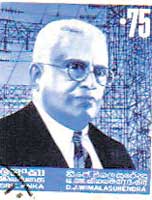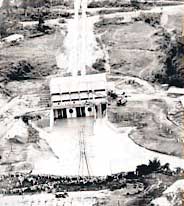August is the month to commemorate two significant events related to hydro power in Sri Lanka. One is the completion of the Laxapana hydro power scheme. The other is that it is the month of remembrance of the pioneer of hydro power in Sri Lanka – D. J. Wimalasurendra (1874 –1953). In a way the story of Laxapana is the story of Wimalasurendra.
If Wimalasurendra got the support from his superiors in the British administration, he would done much more than what he achieved.
 |
| D. J. Wimalasurendra (1874 –1953) |
He was an old boy of Ananda College and showed his talents as a bright star in the galaxy of engineers. Joining the Public Works Department (PWD) as a head overseer, he later worked as a junior engineer. He got side tracked when the Engineering Association of Ceylon ignored his proposal for a hydro project.
A Dutch engineer Ian Van Geyzel whom Wimalasurendra met while working as a District Engineer at Diyatalawa in charge of building camps for Boer War prisoners of World War I, was of much benefit to him.
The friendship gradually led to discussing matters relating to engineering. It was during these discussions that the Dutch engineer who had seen the Maskelioya and the Kirivaneliya (later Laxapana) waterfall running waste to feed the Kelani-ganga, serving no useful purpose, threw up the idea to Wimala-
surendra to harness the water potential to generate hydro electricity in
Sri Lanka.
In 1913, Wimala-
surendra gave his thoughts in the construction of a small hydro power station at Blackpool, between Nanu Oya and Nuwara Eliya, to supply electricity to the Nuwara Eliya town. In 1918, he submitted a project report titled 'Economics of Hydro Power Utilization in Ceylon' to the Engineering Association to make his dream come true.
He estimated that the water potential, combined with Maskelioya and Kehelgamuoya, could be diverted to produce electricity to light 100,000 lamps. Hence the name 'Laksa-pahana,' easily read 'Laxapana.' The idea was to feed power to the national grid. Finally, in 1923, the
colonial Government decided to go ahead with the production of hydro energy and the PWD was entrusted with the work. Yet Wimalasurendra was kept away from any participation in the project.
Once he became the Chief Engineer, PWD, his first action was to separate the electrical section of the PWD. The Colombo Electric Scheme (established in 1918) was taken over by the government to supply power to the Colombo city and the tramways run by Bousteads Ltd. With the establishment of the Department of Government Electrical Undertakings (DGEU) in 1927, a thermal power station was opened in Pettah, in 1929, known as Stanley Power House.
Wimalasurendra was appointed as the Chief Engineer and Deputy Director of DGEU. He retired from service in 1929 at the age of 55 years.
Entering politics after retirement, he was elected to the Ratnapura seat in the State Council in 1931 and remained a member of the Council for four and a half years. Because of his engineering background he was appointed to the Executive Committee of Works and Communication where he contributed immensely to the development of the country.
He argued his case for the resumption of work of hydro scheme left uncompleted by the British Administration and got them re-activated after the war. Accordingly, the Laxapana Hydro Power Scheme, the construction of which started in 1924 was thus resumed in 1938 and done to the finish.
When he died on August 10, 1953, he was at least happy that his dream had become a reality. In regard to progress made in the utilisation of hydro power, credit must go to Wimalasurendra, who
pioneered to achieve the
objective.
The 'Wimalasurendra power house' at Laxapana stands as a monument to the great contribution made by this national hero.
Laxapana Falls
 |
| Laxapana |
The present Laxapana Falls, watered by the Maskelioya, has a drop of 115m. (337 ft.). The Aberdeen Falls (sister of Laxapana), watered by the Kehelgamuoya, has a drop of 91m. (296 ft.). Waters of both flow towards Ginigathhena, then run parallel to each other, and join at Weralu-eliya (Kitulgala), to form the Kelani river, which discharges its confluence into the sea near Colombo.
The historic Laxapana Falls is situated in the village Kirivaneliya (near Norton Bridge), within the Ambagamuwa Korale. The power house is located at the old Waggama village. In the midst of high-grown green gold (tea) stands Therberton Group.
A serious tragedy occurred during the major flood in 1947, when a good number of workmen trapped inside the tunnel conveying water died. A monument has been erected near the Norton Bridge Police Station to mark this unfortunate incident.
Legend has it that when there is less water due to prolonged drought, a golden receptacle appears beneath the bed of the water when it is shallow. When this phenomenon happens, it is said that rain comes down in torrents inundating the lowland areas. |


